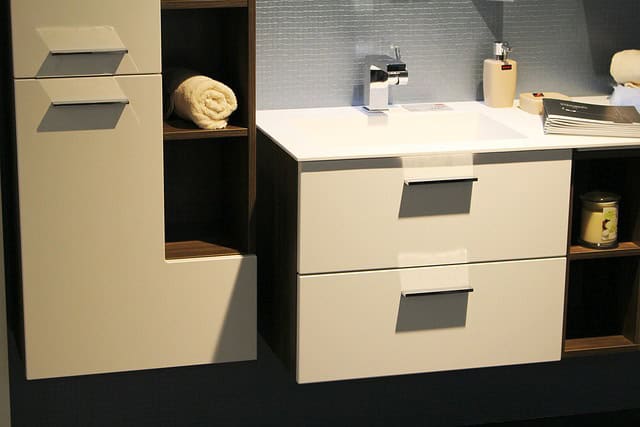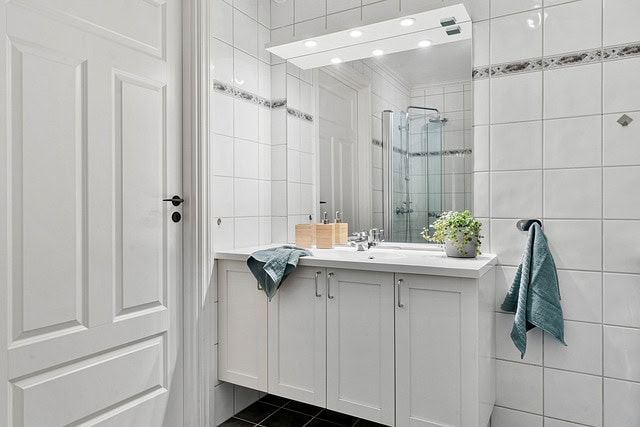When it comes to designing or renovating a bathroom, the terms “bathroom vanity” and “bathroom cabinet” are often used interchangeably.
However, these two components serve distinct purposes and have unique features that set them apart. Understanding the differences between a bathroom vanity and a bathroom cabinet can help you make informed decisions when planning your bathroom space.
In this comprehensive guide, we will delve into the specifics of each, explore their functionalities, and provide a detailed comparison to help you choose the best option for your needs.
Table of Contents
What is a Bathroom vanity?

A bathroom vanity is a central fixture in any bathroom, typically consisting of a countertop, a sink, and a cabinet base. The vanity serves as the primary functional and aesthetic element of the bathroom, providing a space for washing, grooming, and storage. The countertop is usually made of materials like granite, marble, quartz, or solid surface, and can be customized with various styles and finishes to match your bathroom decor. The sink, which is an integral part of the vanity, can be top-mounted, under-mounted, or integrated into the counter. The cabinet base, on the other hand, offers ample storage space, often featuring drawers, shelves, and sometimes even built-in lighting.
Key Features of a Bathroom Vanity
- Countertop and Sink: The combination of a countertop and sink is the defining feature of a bathroom vanity. The sink can be a traditional drop-in, a vessel sink, or a wall-mounted option, depending on your design preferences.
- Storage: The cabinet base provides storage solutions, which can include drawers, shelves, and compartments for storing toiletries, towels, and other bathroom essentials.
- Aesthetic Appeal: Vanities come in a wide range of styles, from modern and minimalist to traditional and ornate, allowing you to tailor the look of your bathroom to your taste.
What is a bathroom cabinet?

A bathroom cabinet, on the other hand, is a standalone storage solution that can be mounted on the wall or placed on the floor. Unlike a vanity, a bathroom cabinet does not include a sink or countertop. Instead, it is designed primarily for storage, offering shelves, drawers, and sometimes mirrored doors. Bathroom cabinets can be used to complement a vanity or as a standalone storage solution in smaller bathrooms.
Key Features of a Bathroom Cabinet
- Storage Solutions: The primary function of a bathroom cabinet is to provide additional storage. It can be used to store towels- Versatile Placement: Bathroom cabinets can be mounted at various heights and locations, making them a flexible addition to any bathroom layout.
- Aesthetic Versatility: Bathroom cabinets come in a variety of styles and finishes, allowing you to choose one that complements your existing bathroom decor.
Bathroom Vanity vs. Bathroom Cabinet: A Detailed Comparison
When deciding between a bathroom vanity and a bathroom cabinet, it’s essential to understand their distinct features and functionalities. A bathroom vanity is a comprehensive unit that combines a sink, countertop, and storage, making it ideal for larger bathrooms where a central washing and grooming station is needed. On the other hand, a bathroom cabinet is primarily a storage solution, offering shelves and drawers without a sink or countertop, making it a versatile and space-efficient choice for smaller bathrooms or as a complementary piece to a vanity. By comparing these elements, you can make an informed decision that best suits your bathroom’s layout and your personal needs.
Functionality
The primary difference between a bathroom vanity and a bathroom cabinet lies in their functionality. A vanity is a multifunctional piece that combines a sink, countertop, and storage, making it the focal point of the bathroom. It is designed to be the main area for washing and grooming, with the added benefit of storage for bathroom essentials. On the other hand, a bathroom cabinet is a dedicated storage solution. It can be used to store towels, toiletries, and other items without the need for a sink or countertop. This makes it a versatile addition to any bathroom, especially in smaller spaces where a full vanity might not be feasible.
Design and Aesthetics
In terms of design and aesthetics, both vanities and cabinets offer a wide range of options to suit different styles and preferences. Vanities can be customized with various materials, finishes, and sink styles, allowing for a personalized touch. Bathroom cabinets, while primarily focused on storage, also come in a variety of designs and can be used to enhance the overall look of the bathroom. Whether you opt for a sleek, modern cabinet or a more traditional, ornate piece, the right cabinet can elevate the aesthetic of your bathroom.
Space Considerations
When it comes to space, the choice between a vanity and a cabinet can make a significant difference. A vanity, being a larger and more comprehensive piece, can dominate the space and may not be suitable for smaller bathrooms. In contrast, a bathroom cabinet is more compact and can be placed in various locations, making it an excellent choice for maximizing storage in a smaller bathroom. Additionally, wall-mounted cabinets can free up floor space, making the bathroom feel more open and airy.
Cost and Installation
Cost and installation are also important factors to consider. Vanities, due to their multifunctional nature, can be more expensive and require more complex installation, especially if they include features like built-in lighting or advanced storage solutions. Bathroom cabinets, being simpler in design, are generally more affordable and easier to install. They can often be mounted with basic tools and do not require the same level of plumbing and electrical work as a vanity.
Maintenance and Durability
Maintenance and durability are crucial aspects to consider when choosing between a vanity and a cabinet. Vanities, with their combination of sink and countertop, may require more regular cleaning and maintenance to keep them looking their best. The materials used for the countertop and sink can also affect durability, with some materials being more resistant to stains and damage than others. Bathroom cabinets, being primarily storage units, may require less maintenance, but the quality of the materials and construction can still impact their longevity.
Comparison Table
| Feature | Bathroom Vanity | Bathroom Cabinet |
|---|---|---|
| Primary Function | Washing, grooming, and storage | Storage only |
| Design and Aesthetics | Customizable with various materials and finishes | Available in a variety of styles and finishes |
| Space Considerations | Suitable for larger bathrooms | Ideal for smaller bathrooms and maximizing space |
| Cost and Installation | Generally more expensive and complex installation | More affordable and easier to install |
| Maintenance and Durability | May require more regular cleaning and maintenance | Generally requires less maintenance, but durability depends on materials |
By carefully evaluating these factors, you can select the best option for your bathroom, ensuring a functional and stylish space that meets your needs.
Conclusion
In conclusion, the choice between a bathroom vanity and a bathroom cabinet ultimately depends on your specific needs and preferences. A vanity is a multifunctional piece that combines washing, grooming, and storage, making it ideal for larger bathrooms. A bathroom cabinet, on the other hand, is a dedicated storage solution that can be used to complement a vanity or as a standalone option in smaller spaces. By understanding the differences and considering factors like functionality, design, space, cost, and maintenance, you can make an informed decision that enhances both the functionality and aesthetic of your bathroom.
What is the main difference between a bathroom vanity and a bathroom cabinet?
A bathroom vanity combines a sink, countertop, and storage, while a bathroom cabinet is primarily for storage and does not include a sink or countertop.
Can I use a bathroom cabinet instead of a bathroom vanity?
Yes, a bathroom cabinet can provide storage and be paired with a separate sink, making it a good option for small or minimalist bathrooms.
Which is more cost-effective: a bathroom vanity or a bathroom cabinet?
A bathroom cabinet is generally more cost-effective and easier to install than a bathroom vanity.
How do I choose between a bathroom vanity and a bathroom cabinet for my small bathroom?
For a small bathroom, a bathroom cabinet is more space-efficient, but a smaller or wall-mounted vanity can also work well.
Can I mix and match a bathroom vanity and a bathroom cabinet in the same bathroom?
Yes, combining a bathroom vanity and cabinet can optimize storage and functionality while maintaining a cohesive look.

